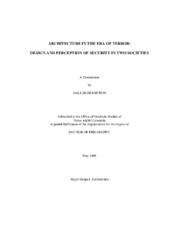| dc.contributor.advisor | Seidel, Andrew D. | |
| dc.creator | Zilbershtein, Gali | |
| dc.date.accessioned | 2010-07-15T00:13:22Z | |
| dc.date.accessioned | 2010-07-23T21:44:41Z | |
| dc.date.available | 2010-07-15T00:13:22Z | |
| dc.date.available | 2010-07-23T21:44:41Z | |
| dc.date.created | 2009-05 | |
| dc.date.issued | 2010-07-14 | |
| dc.date.submitted | May 2009 | |
| dc.identifier.uri | https://hdl.handle.net/1969.1/ETD-TAMU-2009-05-671 | |
| dc.description.abstract | This dissertation falls in the realm of environmental behavior and focuses on the
role of the built environment in influencing responses to threats to personal security
associated with terrorism. The research integrates pertinent knowledge from psychology,
architecture and security/terrorism into a cohesive conceptual framework.
Based on the conceptual framework, this work examined the effects of levels of
terrorism threat (high vs. low) on people who face public buildings (city hall or shopping
mall) that vary in their facade and entrance designs (solid exterior vs. glass facade
with/without designed vs. temporary access control security measures). The research
was conducted in two societies that are different in their experience with terrorism
(Israel and Texas). The effects were measured along four dimensions: how much the
issue of terrorism threat is on a person?s mind, how safe and how anxious the individual
feels, and how likely he/she is to use the building.
The investigation consisted of three quasi-experiments and a pretest survey and
employed a computer-based web driven platform. A total of 1071 undergraduate
students from College Station, Texas and Tel Aviv, Israel participated in these studies. The results illustrate the predominance of the levels of threat of terrorism in
influencing all the examined security-related responses. The characteristics of buildings
affected those responses to some extent. Differences between the two societies were
found mainly in relation to the building-uses. Participants of the two societies responded
similarly to the design elements of buildings. In conditions of low threat of terrorism
participants from both societies had a higher sense of security when they were exposed
to a glass facade compared to a solid concrete facade. In high terrorism threat,
participants from both societies felt safer, and were more inclined to use a building with
a solid facade. However, when access control security measures were visible to
participants in the approach to the building (regardless of their design), both facade
designs elicited a similar sense of security, while the propensity to enter the building was
higher towards a glass facade.
The study concludes with a discussion of the implications of the results for
architectural design. | en |
| dc.format.mimetype | application/pdf | |
| dc.language.iso | eng | |
| dc.subject | perception of security | en |
| dc.subject | function and image of buildings | en |
| dc.subject | exterior and entrance design of public buildings | en |
| dc.subject | terrorism | en |
| dc.subject | environment and behavior | en |
| dc.subject | cross-national | en |
| dc.title | Architecture in the era of terror: Design and perception of security in two societies | en |
| dc.type | Book | en |
| dc.type | Thesis | en |
| thesis.degree.department | Architecture | en |
| thesis.degree.discipline | Architecture | en |
| thesis.degree.grantor | Texas A&M University | en |
| thesis.degree.name | Doctor of Philosophy | en |
| thesis.degree.level | Doctoral | en |
| dc.contributor.committeeMember | Greer, John O. | |
| dc.contributor.committeeMember | Lindell, Michael K. | |
| dc.contributor.committeeMember | Ulrich, Roger S. | |
| dc.type.genre | Electronic Dissertation | en |
| dc.type.material | text | en |


